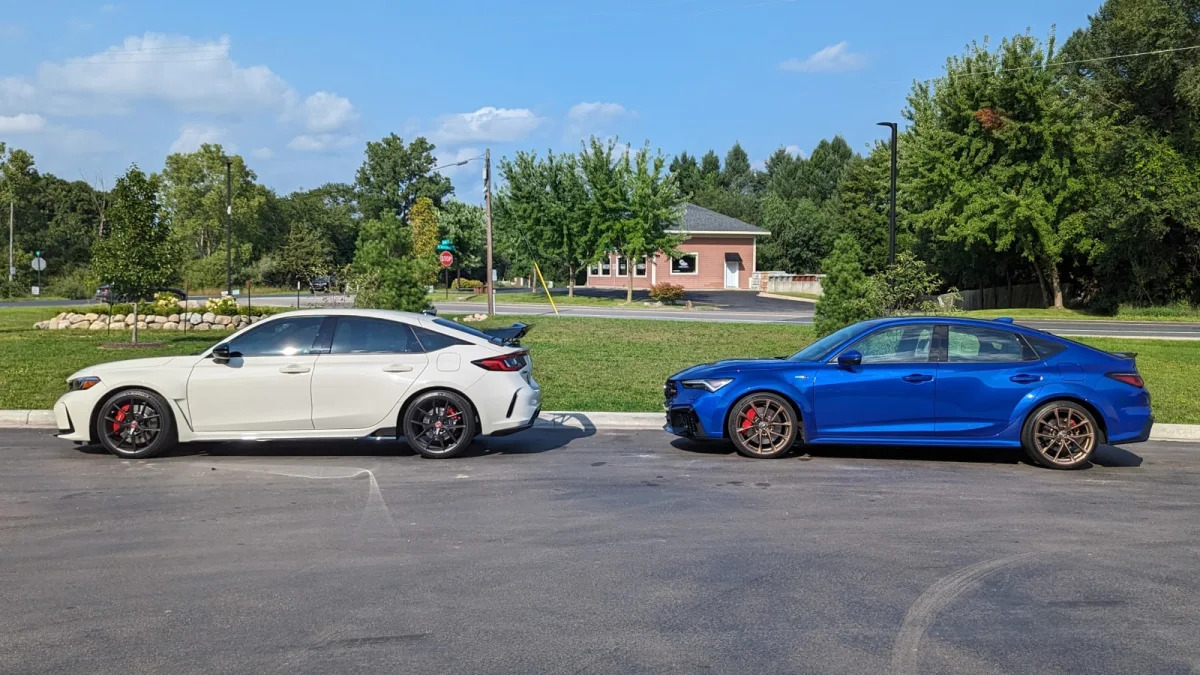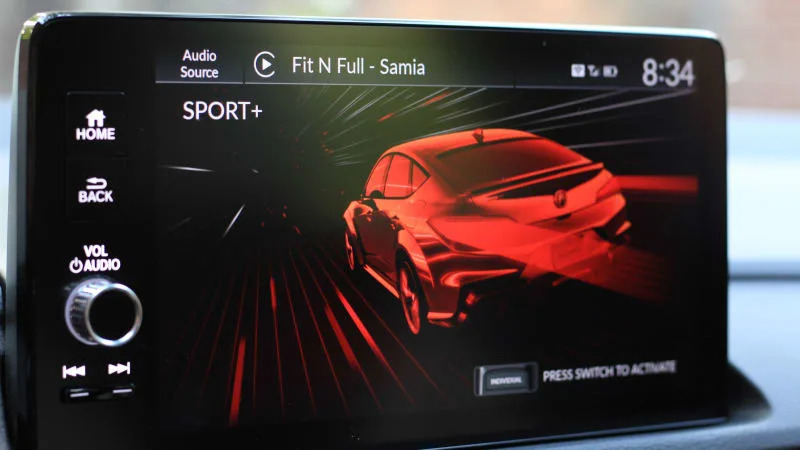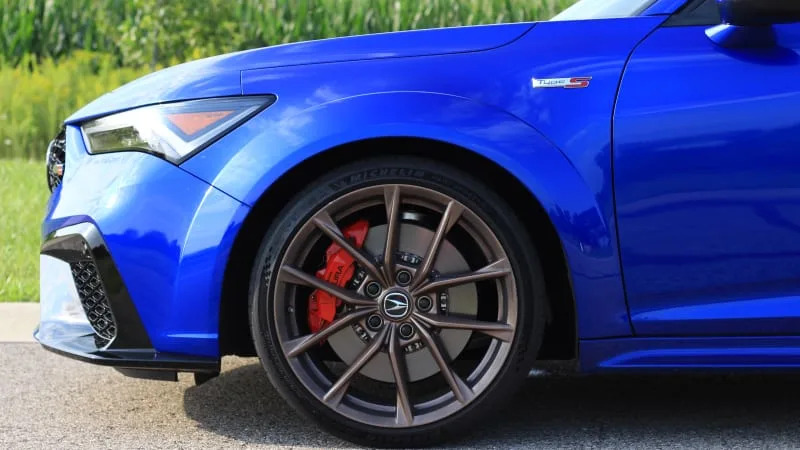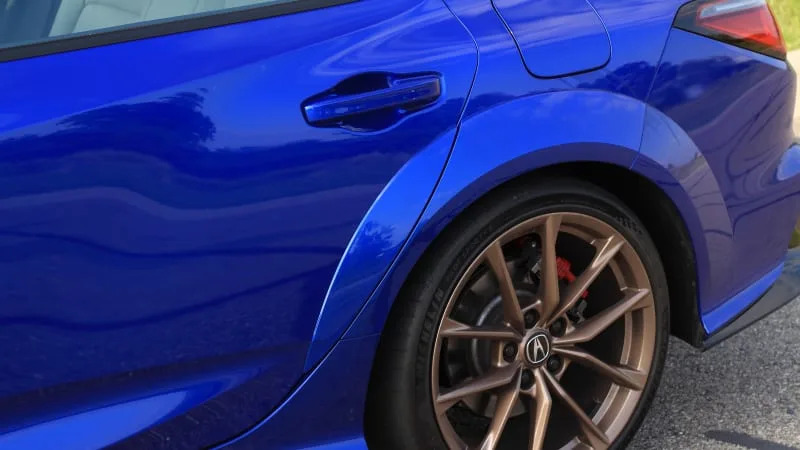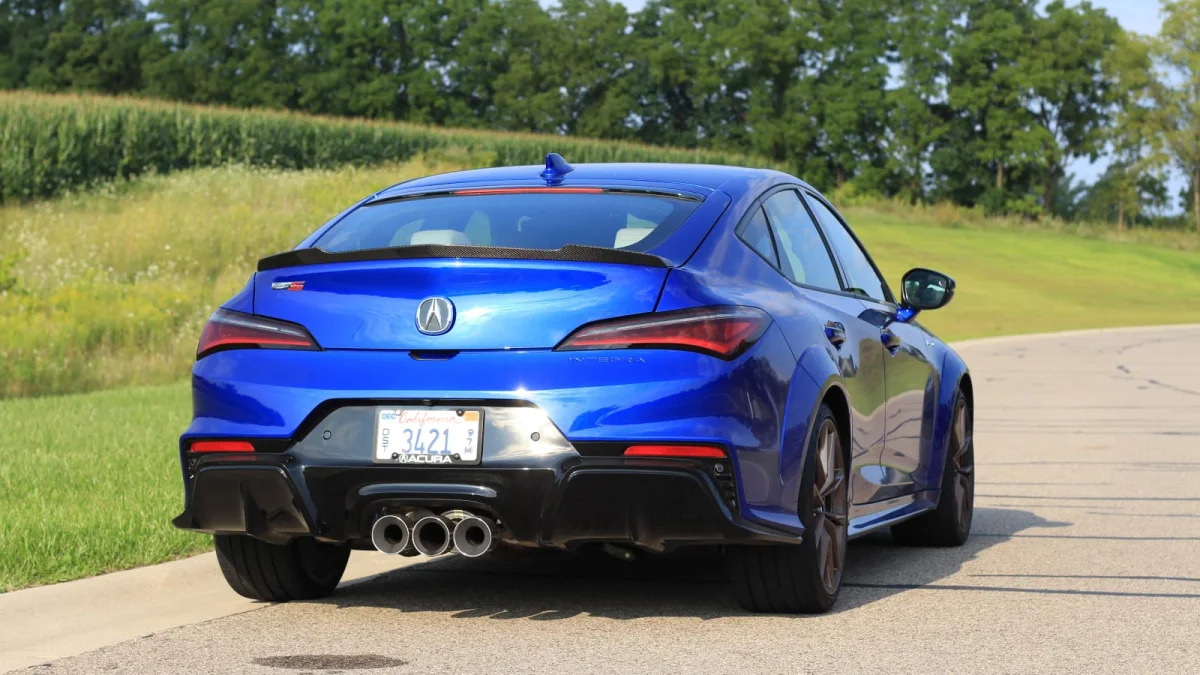It’s so often the case that a truly special driver’s car reveals itself within the first couple hundred feet behind the wheel. The 2024 Acura Integra Type S is one of those cars. In fact, the Integra Type S doesn’t even need that amount road to show itself, because so much of what makes this car magical to drive can be felt standing still in the driveway.
The fizz starts when you push the well-weighted clutch in, then hear the buzzy and vibrating 2.0-liter turbocharged four-cylinder spring to life. It sends vibrations through the car and straight into your body thanks to the purposefully lacking balance shafts. Little turbocharged motors are typically lacking in character, but the Integra Type S’ engine feels like it’s alive and bumbling with energy at idle. Before you even start to find revs, this engine presents as one designed for performance.
Take a spin through the six-speed manual transmission while stationary, and it quickly becomes obvious why Honda is the standard when it comes to manual transmissions. It’s a combination of the natural fluidity moving through the pattern – going both up and down, each gear seemingly selects itself as your wrist guides the stubby shifter along – and the mechanical click-clack connection you feel through your hand with each shift. The sheer amount of satisfaction it brings to make every last gear change is enough to make any manual enthusiast giddy.
I ease off the clutch for the first time, and start to roll those thick 265-section-width tires forward, quickly revealing the perfectly weighted steering rack, clueing me in on how serious this chassis is. The view forward is spectacular past the thin A-pillars. The exhaust goes bang, ratta-tat-tat on the overrun as I ease up to the first stop sign. And the brakes only require a gentle whisper to the mega-responsive pedal to bring this hatchback to a stop. It only takes that couple hundred-foot stretch to realize that this Type S is exactly what I know it to be: a Honda Civic Type R in a different outfit.
The comparison is impossible to avoid, and the Honda community may spend the next 50 years debating which one is better – trust me, there will never be a clear-cut answer – but it’s undeniably great that we all get to choose between these two similar driving beasts. Thankfully, no matter which one you choose, neither will ever be the wrong answer.
The first night of testing the Type S is a chilly one, but stubborn me keeps the windows down to ensure I soak in every last bang and pop the Integra’s unique exhaust has in store. To combat that chill, summer breeze, I crank the standard heated seats in the Type S. If the test car were so equipped, I could even activate the optional heated steering wheel. You can’t do that in the Type R with its unheated bucket seats and unheated steering wheel. However, the Integra’s leather seats are sure to get way hotter in summer, and without a ventilated seat option, the cloth-covered Type R seats may end up being the more comfortable option. And as far as performance is concerned, the Type R’s buckets are undefeated in both support and comfort. The Integra’s power seats are a nice luxury to have, but why are they not memory-supported? Half the enjoyment of power seats is in being able to switch between drivers easily, but if someone else drives your Type S, you’ll be on the hook for finding that perfect driving position on your own again, just like your friend in a Type R. At least the Type S has power lumbar, which is an amenity the Civic has no answer to.
Acura’s unique damper tune for the Type S is another driving aspect that the Civic is answer-less to. The Civic Type R is a stiff-riding car; there’s no denying that. And the Type S is, too, but the extra forgiveness in the Integra’s ride is a godsend on the Midwest’s terrible roads. Instead of thinking, well, it’s bearable in the Civic, the Type S offers up a ride that can pass for enjoyable when you have the dampers in their Comfort mode. If you’re driving on rough roads frequently or simply don’t care for being beat up on your commute as much, the ride quality of the Type S is quite possibly its biggest selling feature. Acura calling out the Type S as a street performance car could not be any more accurate, because the street is where this hot hatch trumpets its Acura supremacy the best. Course, throw both onto a racetrack, and it’s practically a sure thing that the Type R would be the preferable weapon.
Both truly are driving weapons, though. The limited-slip differential doling out power to the Integra’s front wheels is the most impressive ingredient of all alongside the Dual-Axis torque steer-quelling suspension design and unflappable chassis. It’s not often – well, it actually almost never happens – that I get out of a car after properly putting it through its paces and don’t have at least a few critiques or items to improve on. With the Type S, however, every last aspect of how it drives gets a gold star. It’s confidence, grip and sheer performance bottled into a FWD hot hatch.
The lack of exhaust drama exhibited by the Type R is eliminated with the Integra, and that was the start and end of my complaints about the Civic. Depending on the roads you frequent, the Integra’s damping could be helpful to shrug off the worst of the bumps and potholes, but both cars are pretty good at that so long as you keep them in the Comfort damper setting.
The 320 horsepower and 310 pound-feet of torque – 5 ponies more than the Civic – is pushing the limits of what a front-wheel-drive car can handle. Spinning those front wheels happens without even thinking in first gear, and the freight train of acceleration really picks up in second and on into third. This car only weighs 3,219 pounds, which means the 320 horses are rather effective for sustained acceleration up to and beyond highway speeds. And unlike the high-strung VTEC-equipped Hondas of yore, the Type S has serious pulling power at highway speeds from the meaty, turbo-propelled torque band. And even though Honda is giving you all the low-down torque, it’s still not compromising the top-end of this 2.0-liter turbo. Revving it all the way out to the 7,000 rpm redline is essential. Turbo lag is plenty noticeable when you roll into the throttle off-boost and from a stop, but the way this engine revs is natural and shockingly scintillating for its makeup.
The lack of exhaust drama exhibited by the Type R is eliminated with the Integra, and that was the start and end of my complaints about the Civic. Depending on the roads you frequent, the Integra’s damping could be helpful to shrug off the worst of the bumps and potholes, but both cars are pretty good at that so long as you keep them in the Comfort damper setting.
While I really don’t have anything bad to say about how the Integra Type S drives, it’s still not the perfect car. Weird hangovers from the Type R infect it and make it a worse luxury car. For example, you can’t add a moonroof as an option even though it’s available on the regular Integra. Also, unlike the standard Integra, the Type S is a four-seater, adopting the Type R’s strange cupholder-filled section where a middle seat might go on the rear bench. For those that might want to track their Integra Type S, the lack of Honda’s LogR software is another downgrade, and the same can be said for the Integra’s digital instrument cluster that is notably way less cool than the Type R’s, which offers more colorful gauges and a sweet, horizontal tachometer option. There are no shift lights, nor is there the shift beep that comes on the Type R, giving further credence to the Type R being the better track companion.
It’s also worth griping about the piano black shifter surround that will inevitably look like scratched-up garbage in a couple of years’ time. The swooping soft-touch dash design does a decent job of classing the cabin up, but Honda made the Type R’s interior so incredibly nice that the only way to outclass it with the Acura is with features like the head-up display and ELS Studio audio system. Both of those are features I really wish made it to the Type R, but now they’re fantastic quality-of-life improvements for anyone opting for the Integra, especially the ELS system that blows the Civic’s Bose audio setup out of the water.
Despite some of these nits to pick and small wins each car has over the other, it’s important to not lose sight of how close to perfect the Integra Type S and Civic Type R both are. Those first couple hundred feet might fill you with tingly feel-good feelings, but every mile thereafter cements those initial feelings into astonishment that a little FWD hatchback can be this good. I could drive this car for days, months, even years, and still want more after I get out.
The Integra Type S’ price at $51,995 is steep, but there isn’t another vehicle within spitting range (outside of the Type R coming in at about $7,000 cheaper) that I’d rather put in my garage. Which one you go with could very well be down to design preferences. Personalization is a massive strong suit of the Type S since it features more exterior and interior combinations than the Type R does. If I had my pick, though, I’d park the Integra in the driveway on account of the suspension tuning, hilarious exhaust and the added luxury amenities.
Related video:


